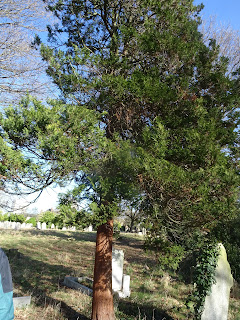The Trees of Kingston Cemetery
Conceived in 1854, Kingston Cemetery along Bonner Hill Road, Norbiton comprises 32 acres of parkland and was opened in 1855. Burials include Thomas Hansard recorder of Parliamentary debates, A.C. Ranyard editor of Truth magazine and Dr Joseph Moloney, an African explorer. The only bronze is the tomb of Dorothy Burton 1908 - a listed monument cast at her parents foundry in Thames Ditton. I love searching the council website for grave records
For many years the cemetery was a special plot in the national Common Bird Census surveys convened by the British Trust for Ornithology. It was started by Duncan McNeil, and Surbiton and District Birdwatching Society, which I participated in during the 1980's and 90's; we have about twenty years of good data for birds (and plants). If you put 'cemetery' into the search box at the top left corner several posts on the wax caps and roll rims; orange peel and honey fungus appear - but very little on it's trees - and predictably only those notable oaks and deodars or the so-called 'specimen' trees.
Sawara cypress Chamaecyparis pisifera
There are many trees that are unremarkable; when we took a look before Christmas, we were uncertain of the provenance of the coniferous trees. We asked John Wells to come and take a look to help us key out our confusion. Not realising some trees were present just because we had taken for granted everyting was a Lawson or Lleylandii. See if for example if you can spot this Sarawa cypress tree - one of the commonest evergreens in the newer portion of the cemetery (the lower slope at the town end). Many of them have a trendy lean to the left, depending on your perspective of course. The red, soft, stringy bark is reminiscent of redwood. The Collins guide describes the bark as red and grey but only the oldest of their number displayed any greyness (and perhaps a lean to the right). The horticultural effect of crossing this tree has been to make the 'leaves' or scales appear 'spread' or juvenile rather than as a sheath.
Strange fruit
Lawson cypress
Nevertheless, there are several Lawson cypress trees in the cemetery and their size suggests they were planted at the same time. They come in a great variety of colours as there are 200 horticultural varieties. First the scent is parsley- like, look for the droopy top, and then the small cones. Although many of the characteristics of the tree on the left were common with Lawson, we it could not be identified due to the large cones. On the right is the only stand of blue Lawson trees the rest are golden especially in the sunshine.
Of the true Lleylandii x cupressus crosses were many shapes and sizes. First recorded when Nootka cypress hybridised with a Monterrey cypress around the 1870's. Characteristics are the lemon smell, the 3D appearance (i.e. the tree has upward sprouting leaves as well as flat leaves). A favourite with birds as can be seen from the amount of bird droppings found within the branches. During bat surveys I have seen many song thrushes, blackbirds and starlings flock to communal roosts in Lleylandii trees and it is certainly favoured by goldcrests for nesting purposes.
There are several cedars in the cemetery including a Deodar - with dropping branches - at the main entrance on the left. A cedar of Lebanon in the south-east quadrant is not looking in great shape and has had quite a lot of 'surgery'. This blue Atlas near the rose garden with its slightly upturned branches, is stunning.
A walnut - near the Dawson road entrance - was eventually identified by twigs with spirals of mitre - shaped buds along its and its silvery trunk. It took a while to find it along a boundary line of trees, in a similar age class, but were found to be ash and three Norway Maple pollards. The silver birch is probably the oldest in the cemetery and we checked in case it was pubescens or downy birch. However under a hand lens the tell-tale white spots along the twigs were present.









Comments
Post a Comment
Please share your thoughts